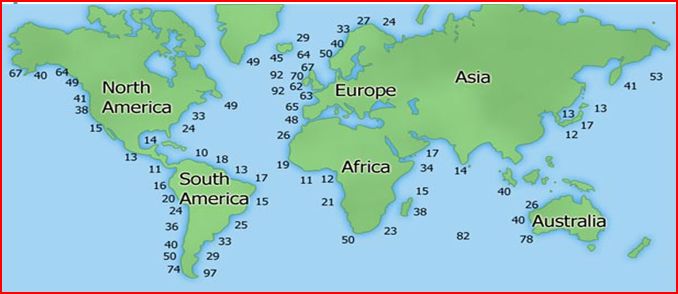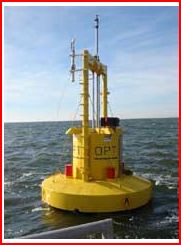Wave Energy: Is it Scalable? Is It Efficient?
Wave energy, in principle, is a source of renewable energy that has not yet been exploited on any significant scale. While wave energy is highly variable hourly and seasonally it is continuous over 24 hours which gives it a principle advantage over wind and solar. Wave power which is incident on a shoreline is usually measured in units of KW per meter where the meters refer to the length of the wave front. The map below shows some world wide values:

The best sites are:
- The North Atlantic off the coast of Ireland - some experimental devices have been deployed there and are discussed below.
- The Gulf of Alaska - a difficult environment
- The Cape of Good Hope - an extremely difficult environment
- The SW coast of Australia off of Perth - this is very promising
- Portugal - and devices have been deployed there.
- The Washington and Oregon Coastlines are also decent
The power per meter in an ocean wave depends on only two physical parameters:

- The square of the wave height (H or A)
- The period of the waves (T) - the period is simply the wave frequency which is the number of waves per minute that strike your wave energy device
Thus, to maximize ocean wave energy you would build something that either maximum wave height or maximum frequency of both. The problem with maximum wave height is that the wave is more destructive and therefore the device has to be pretty damn sturdy. Wave frequency is generally determine by coastal topography and sites with high frequency are therefore good.
So let's consider a hypothetical deployment off the Oregon Coast to estimate what the total yield might be. This estimate is based on the following components:
- The average wave power is 40 KW/m
- Wave energy device is 10% efficient
- Total length of the Oregon Coastline is 600 km.
The total power yield is then 40 kw/m * 1000 m/km * 600 km = 24000 MegaWatts. In 2010 Electrical Power requirements for Oregon was
14,200 MW.
Thus, in principle there is enough incident wave energy on the Oregon Coast to easily power the State. Of course, this would mean building devices on every km of the Oregon coast which is neither desirable or practical.
This example leads to the following idea, which is also very much part of the role of conservation in energy management. Suppose the citizens of Oregon, responding to yet another enlightened initiative, decides that 10% of all electricity generated in Oregon comes from wave power.
That means 1420 MW should come from waves:
- at 10% efficiency that means using 1420/40 = 35 KM of Oregon Coastline.
- In general, the efficiency will increase (up to a point) when smaller areas are involved so in the case of 40% efficient devices this would mean devoting approximately 10 km of Oregon Coast line would meet this target.
Such a pilot program is now occurring off the coast at Reedsport OR. Note: please actually go to that link and read it. You will find that each individual Buoy generates 150 KW, weighs 200 Tons, and costs $4 Million:
- 200/150 = 1.3 Tons per KW (see more on this below)
- 4 million/150 = 26.6 dollars per Watt
 WTF; why would anyone do this? WTF; why would anyone do this?
Update May 2014: The project is now
cancelled
Oregonian Article
 The Reedsport project is meant to deploy 10 power buoys for a total project nameplate of 1.5 MW or 1.5/14261 = .01% of our Oregon's electricity generating portfolio. At such a small scale the project doesn't seem too sensible and if you scaled this up to provide 10% contribution this would require deploying 1000 Bouys @$4 million each or $4 Billion!! The Reedsport project is meant to deploy 10 power buoys for a total project nameplate of 1.5 MW or 1.5/14261 = .01% of our Oregon's electricity generating portfolio. At such a small scale the project doesn't seem too sensible and if you scaled this up to provide 10% contribution this would require deploying 1000 Bouys @$4 million each or $4 Billion!!
Ocean wave energy basically represents a mechanical source of energy that, if interfaced with the proper device can simple transfer than energy to make something in that device move. In the case of the buoy it moves up and down to generate electricity If something moves, then what moves could be coils of wire or magnets, the two necessary components of any electrical generator.
From the physics point of view, the efficiency of energy transfer is important and that efficiency is device dependent.
But independent of the actual wave energy device, all such devices suffer from one main problem:
Since ocean water is 850 times denser than air, any device that is built to intercept an ocean wave will experience significant forces. If the device breaks when the wave hits it then that would have been a stupid design. Moreover, the device has to withstand strong storms, and in the past, some devices have been destroyed in storms.
What this all means is that wave energy devices have very high material intensity and very unfavorable ratios between device mass and power output. Typically a wave energy device has a ratio of 1 ton of material needed for every 1 KW generated.
This ratio is 10 times worse than wind energy. In other words, a 10 KW
wind turbine would weigh 1 ton, a 10 KW Ocean wave Power Bouy would weigh at least 10 tons
In a world that is currently running out of materials, the material intensity associated with building renewable energy devices is an important consideration. While wave energy devices are now trying to be designed that are less material intensive, the basic physics of the situation sets limits.
There is also another fundamental conceptual difficulty associated with wave energy: In a wave, the energy content is continuously distributed through our the entire wave. This means that to capture the entire energy of the wave you need to build a device that is as long as the wave. To get around this situation you would have to build a device to focus, collimate or attenuate this distributed energy into a smaller area (just imagine a really big funnel). The device design challenge then is concerned with two questions:
- how big of device is needed?
- what is the efficiency of converting mechanical wave energy into electricity for that device?
Finally, there is the consideration of device placement. There are basically 3 choices a) off shore; b) near-shore; c) on the shoreline/coastline.
When a wave is off shore it is basically a swell which is mostly vertical movement of the ocean surface. This is basically how the Power Buoy operates. The two problems with this location are a) swell energy is less than actual wave energy and b) grid connections off-shore are difficult and expensive.
When the wave is near shore it is at its maximum height (amplitude) and energy. Such waves are often surfed upon and it would be an environmental disaster to deploy in that location.
When the wave impacts the "shoreline" it is breaking and losing energy. However, this is off set by easy access to the shoreline thus lowering construction costs (but of course environmentally altering the shoreline).
In sum, wave energy would seem to have more drawbacks than advantages particularly if your talking about shoreline installations. Off shore swell energy devices are likely the best compromise provided you can export the electricity from such arrays.
The next "lecture" will discuss some devices and classes of devices in more detail, including some actual real world deployments.
|
 WTF; why would anyone do this?
WTF; why would anyone do this?